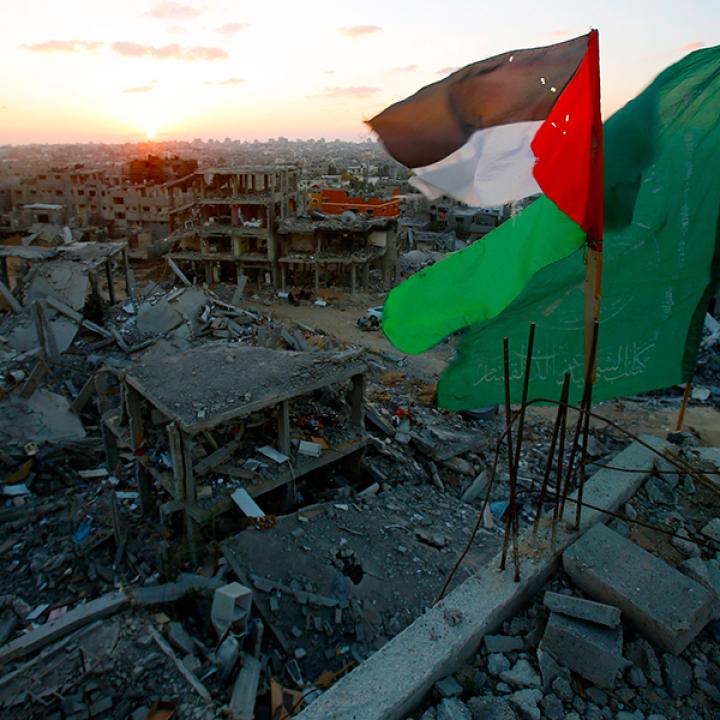
- Policy Analysis
- Fikra Forum
What Gazans Really Want: Hard Data About A Hard Problem

June 20, 2017
This month marks the tenth anniversary of the violent Hamas coup that took control over the 1.9 million Palestinians in the Gaza Strip. There is still no end in sight to their predicament – but this is most certainly not because Hamas enjoys popular support among the local population. In fact, reliable data from a new survey conducted there May 16-25 by a professional, independent Palestinian pollster demonstrate that only 14 percent of Gazans self-identify as Hamas supporters. That is far behind the popularity of Fatah, which runs the Ramallah-based Palestinian Authority (PA), which garners 41 percent of Gazans’ self-professed affiliation. Indeed, the large majority of Gazans – 77 percent, including 41 percent who feel strongly about it – agree that “the PA should send officials and security officers to Gaza, to take over the administration there.”
So why, despite this popular will, does nothing change in Gaza? It is because the PA has refused to assert its role in that territory, while Hamas has refused to risk its rule by holding any elections there for the past decade. The result is continued Hamas rule, by force of arms. And the people of Gaza know it; three-quarters, up sharply from 35 percent in the previous June 2015 poll, now say that elections should require Hamas to “give up its separate armed units.” Since Hamas has no intention of doing that, there are no elections, and the people of Gaza are left with no choice in the matter.
Moreover, key Hamas policies are also highly unpopular in Gaza. Hamas rockets started a disastrous war against Israel in July 2014; but then as now, the overwhelming majority of Gazans (80 percent today) want Hamas to “preserve a cease-fire with Israel.” And more surprisingly, on the political level, the majority of Gazans (62 percent) also say that “Hamas should stop calling for Israel’s destruction, and instead accept a permanent two-state solution based on the 1967 borders.”
Economically, too, the survey shows that Gazans are suffering under Hamas rule. Two-thirds report a monthly family income of under 1,200 shekels (around $330) – compared with just 8 percent of West Bankers, most of whom report monthly incomes of at least twice as high. This helps explain why the majority of Gazans, more so than West Bankers, desire economic relief even from Israel: 69 percent want more jobs in Israel, and 54 percent want Israeli companies to provide more jobs inside Gaza and the West Bank. Notably, half of Gazans also say they would accept an Arab offer of “extra economic aid in order to resettle Palestinian refugees in the West Banks or Gaza but not inside Israel.”
Asked whom they blame most for their economic misery, fewer than half (46 percent) of Gazans single out Israel. The rest blame other actors: Hamas, 26 percent; the PA, 11 percent; the UN, 11 percent; or Egypt, 4 percent. The last number is remarkably low, considering that (according to UN statistics Egypt kept Rafah, its only border crossing with Gaza, completely shut for 322 days last year.
Most surprising of all, Gazans today are more moderate than West Bankers on the key question of permanent peace with Israel. Asked about future options “If the Palestinian leadership is able to negotiate a two-solution, a narrow plurality of Gazans (47 percent), up 13 points since 2015, said “that should end the conflict.” Forty-four percent take the opposite view: the conflict “should continue until all of historic Palestine is liberated, but just 24 percent think that is a realistic goal “for the foreseeable future.” On the West Bank, however, these proportions are reversed: a narrow majority (55 percent) says the conflict should continue even after a two-state solution; while 34 percent say that should be the end of the conflict with Israel.
But interestingly, regardless of these personal preferences, Gazans are much more likely than West Bankers to attribute this maximalist goal to the PA. The survey asked respondents to interpret the fact that “the PA publishes official maps, declarations, songs, and poems about … cities like Haifa, Tiberias, Acre, Jaffa and others inside pre-1948 historical Palestine.” Only 28 percent of West Bankers said this “shows that the PA’s real intention is to liberate all of historic Palestine someday”; a plurality, 40 percent, said, “it should not be taken seriously because the PA’s only goal is a Palestinian state in the West Bank and Gaza.” Yet among Gazans, these proportions were reversed: 46 percent said the PA’s real ultimate goal is to liberate Palestine in its entirety; just 27 percent thought the PA would remain content forever with a two-state solution.
What could account for this striking dichotomy, in which Gazans are personally more moderate long-term than West Bankers, yet also more likely to attribute maximalist intentions to the PA? The answer almost certainly lies in the differing direct experiences of these two Palestinian populations. Gazans are much more familiar with the devastating consequences of endless war against Israel. And West Bankers are much more familiar with the equivocal policies of the PA.
Finally, asked about “the one thing you’d most like the U.S. to do about the Palestinian issue these days,” Gazans exhibited an intriguing variety of choices. Only a quarter picked “put pressure on Israel.” Most of the rest were divided among “increase economic aid,” 29 percent; “put pressure on the PA and Hamas to be more democratic and less corrupt,” 19 percent; and “help get Arab states more involved,” 12 percent. Perhaps the most pleasant surprise of this poll was that just nine percent of Gazans selected this option: the U.S. should “stay out of Palestinian and Middle East affairs altogether.”

